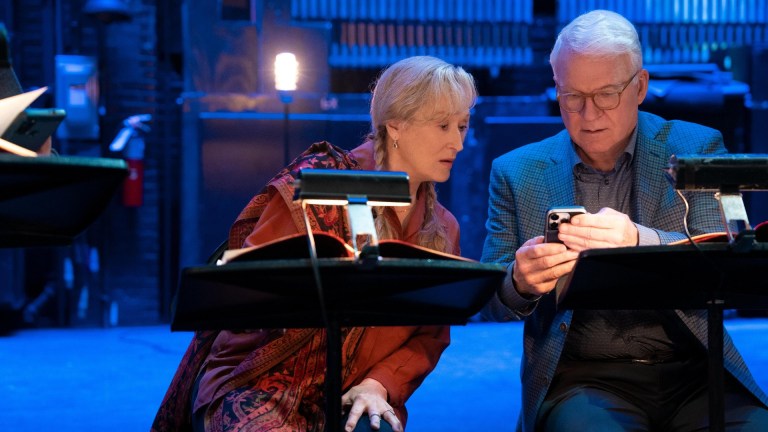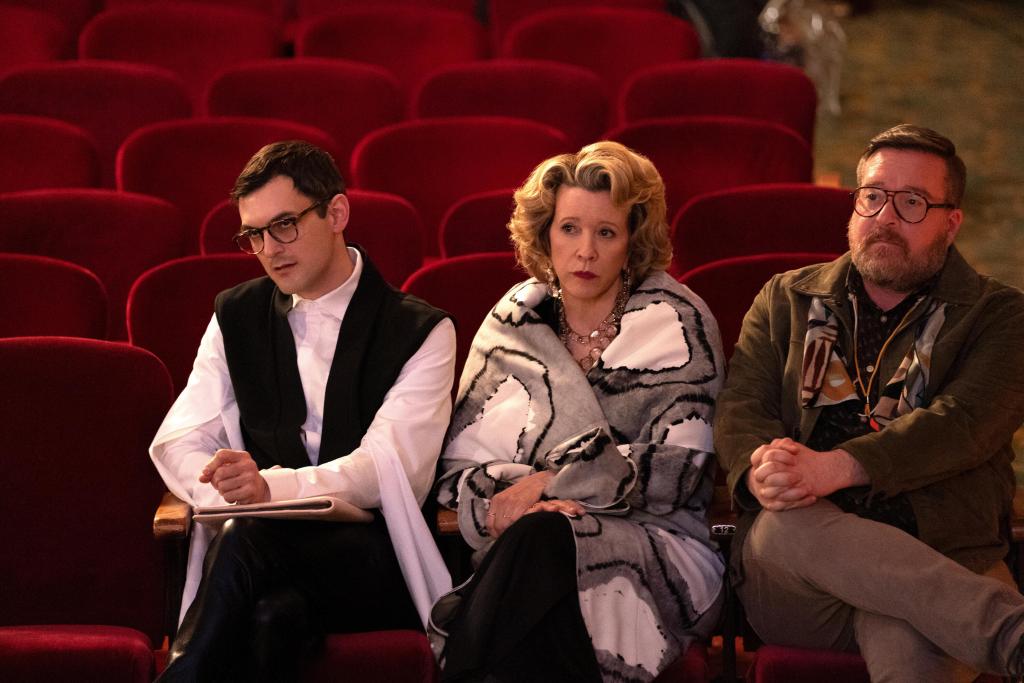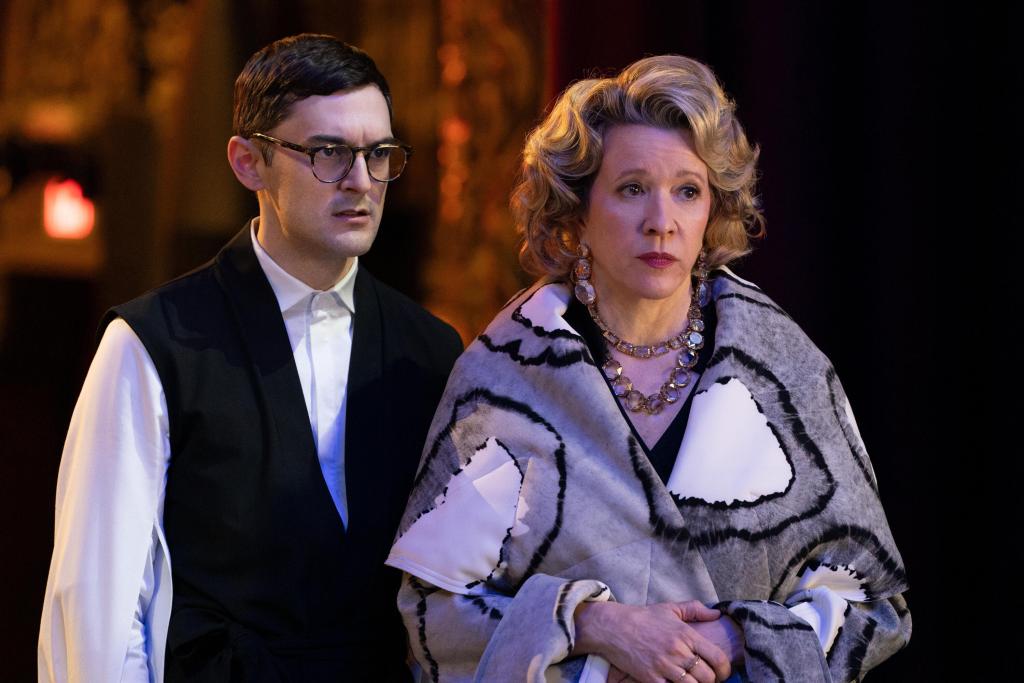Only Murders in the Building Season 3: Did the Title Clues Reveal the Murderer?
Only Murders in the Building season 3 might have hidden the killer in plain sight - if you knew where to look.

This article contains Only Murders in the Building season 3 spoilers.
It wouldn’t feel like late summer transitioning into the crispness of fall if there wasn’t another season of the perennial comedic murder-mystery Only Murders in the Building. Co-creators Steve Martin and John Hoffman’s New York seems to hone in on the magic of the Big Apple, wrapping you in colorful cardigans, raining orange leaves upon you, and allowing you to curl up and enjoy witty one-liners and the charming score of Siddhartha Khosla.
But don’t get too comfortable.
Like the real New York, the charm is juxtaposed with some big city crime, and in the third season, that is the murder of faded Hollywood star Ben Glenroy (Paul Rudd). Ben collapses on opening night of “Death Rattle” – the play that could give Oliver (Martin Short) a new lease on his career. It also gives Charles (Steve Martin) an opportunity to get away from his cult-classic television character and act under Broadway lights.
Last season, Den of Geek broke down the hidden easter eggs found in the show’s equally charming title animation, but this season, the clues seemed to hold a deeper meaning than merely revealing a key motif in the episode. Keen investigators will notice these tiny visual nuggets may have connected to the identity of the murderer the entire time. And based on the final reveal of who the murderer was, they may have been right!
Episode 1: The Footlights
At first, the footlights may appear to be simply a nod to the fact that this season is much more theatrical and musical than ever before. With Oliver getting his shot at redemption and Charles co-starring in the play, the footlights seem as though they may just be “illuminating” the bright new start of a season which prominently features the stage. But it could also be a subtext regarding the killer.
Footlights are typically used as soft, ambient light. Without them, the shadows that were cast from the bright overhead lights would be too sharp and dark. Is this the show’s first clue in terms of the killer? It could be someone attempting to soften the darkness that surrounds the show, and protect someone else, much like Loretta (Meryl Streep) admitting to killing Ben in order to protect Dickie (Jeremy Shamos) from being arrested and harassed in episode eight.
Episode 2: The Blue Flames
While Oliver is preoccupied, Mabel (Selena Gomez) and Charles follow their early lead and team up with Ben’s alleged security guard, Gregg (Adrian Martinez). Turns out, Gregg is perhaps the antithesis of security, as he reveals himself to be an obsessed Ben stalker. He gets the best of Mabel and Charles, tying them up and threatening Charles with a blue torch before thankfully being arrested. Gregg is then charged with the murder of Ben, but Mabel is not convinced.
Yet the title animation for the second episode shows two blue flames, both emanating from the water towers in the skyline. Why two? It has to have more meaning behind it than simple symmetry. Perhaps it is to reveal that the hatred between the murderer and Ben burns with the intensity of a blue-hot flame, maybe the number alludes to two brothers? Or perhaps the number is more significant. Could it be that there is a tandem working together within this season that is ultimately responsible for Ben’s death?

Episode 3: The Lighthouse
The cityscape in the opening sequence is often used for subtle little Easter eggs, but in episode 3, the creators went a bit brighter. A lighthouse sticks out on the right hand side of the screen, not only due to its luminosity, but the fact the quaint tower is more suitable for the shores of Halifax than the Manhattan skyline.
In one of the definite highlights of the season, Loretta launches Oliver’s new vision for the show almost single-handedly. Adapting the story into “Death Rattle Dazzle,” now a musical, one of the beautiful featured songs of the episode is “Look for the Lights” (co-written by the uber talented Sara Bareilles).
One of the more note-worth lyrical lines is “My Love is a Lighthouse,” and those particular lyrics seem to have a very personal meaning for Loretta as she sings them. Originally audiences are led to believe that she is singing to her paramore, Oliver, but it’s later revealed that Loretta was in fact Dickie’s biological mother, and singing to her long lost baby boy. Since the context of the song is Loretta’s nanny character singing to three small infants, it seems only fitting that she sings to Dickie.
Perhaps the featured lighthouse at the start of the episode is not merely a loving monolith to the song, but to another loving relationship between two featured characters this season. That same type of maternal love, as strong as the beacon from a lighthouse is featured prominently between the mother-son producing team of Donna and Clifford DeMeo. It’s no coincidence that Loretta’s performance convinces Clifford to take a chance on Oliver’s new vision.
Episode 4: The White Rooms
The use of color in any given episode is one of the major draws of Only Murders. The production design team, especially the costumers, use brilliant palettes to evoke strong emotions and create homages to classic cinematic moments.
The opening features another fall-like motif of forest-greens, vibrant reds and darker yellows, which appear even brighter when the opening shifts to night. The famous Arconia, the title building in Only Murders in the Building fills the night with windows typically tinted with those aforementioned colors.
Except in episode four. Suddenly all the windows are a stark, extremely noticeable white. This is a reference to a major motif throughout this episode as Charles mentally travels to “the White Room,” a dreamlike space in his head where actors often go when they panic on stage.
In one of the most subtle and brilliant writing moments of the series, the White Room was the one episode that didn’t really focus on the murder at all. It was an episode that almost entirely featured a secondary story. Perhaps it’s no coincidence that those who witnessed Charles’ white-room-breakdown aren’t the major suspects in the murder investigation. Since the Easter egg doesn’t actually relate to the murderer, could the killer be someone who missed the White Room entirely?
Episode 5: The Puffs of Smoke
Love is in the air, almost literally, as two smokestacks puff out the shape of little hearts into the New York sky. Once again, it’s interesting to note that there are two chimneys releasing the smoke, not just one. This thematic use of two images, much like the two flames, is so purposeful it has to pertain to a pair of characters being the major motivation behind the murder.
And who is to say that the heart clouds automatically mean romantic love? It could represent the love between two brothers. Or the love between two friends. Or even… the love between a mother and her son?

Episode 6: The Sandbag
This Easter egg drops down like a ton of bricks, almost literally. Right at the end of the title sequence, as the three animated versions of Mabel, Oliver, and Charles stand outside the Arconia, a sandbag plummets from the sky inches from Charles, creating a thump. While this exact event occurs in episode 6, entitled “Ghost Light” – the cast and crew of “Death Rattle Dazzle” easily blame the event on the ghost of Gideon Goosebury, the unofficial keeper of the theater whose energy needs to be swept away every night.
The method seems to have a subtextual meaning as well. It wasn’t a fire on ground level, or a slip off the stage, it was death from above, perhaps hinting at the fact that the murderer is someone close to the theater, but up on the catwalk. Someone important. Someone virtually untouchable.
Episode 7: The Wallpaper
The ridiculous nature of “Death Rattle” is certainly a notable part of this season. The plot of the play, and in turn the musical version is a mysterious murder where the only real suspects are three infant triplets (making the title of the show an absolute dad-joke-level pun). One of the victims is even found with a rattle rammed down her throat.
One major part of the mystery was the podcasting trio of Mabel, Charles, and Oliver trying to track down who was missing a handkerchief. The cast were all given matching handkerchiefs from Ben on opening night as a cast gift, and featured on the handkerchiefs was an embroidered pattern of baby rattles. That same pattern can be seen on Charles’ wall in the opening sequence.
Yet the timing seems so purposeful. They have been searching for these handkerchiefs since the start of this season, so why leave it as an Easter egg now? The visual of a baby rattle can clearly relate to what is later revealed to be the relationship between Loretta and Dickie, but what if they are a red-herring all along?
Perhaps it’s another mother-son duo we need to worry about.
Episode 8: The Conductor
Much like the lighthouse episodes earlier, in episode eight’s title sequence, a conductor’s silhouette, featured as large as any building, stands on the roof of the Arconia seemingly commanding the night’s sky. It’s a clear visual nod to the episode being all about Death Rattle’s sitzprobe – a musical rehearsal where the actors and the orchestra finally work together for the first time.
It harkens back to a similar clue with the sandbag. A conductor, much like “death from above” is a position above most people in a theatrical production. Someone who has access to everything. Someone who is again, almost untouchable. This visual clue is a strong hint that our murderer is someone involved in the play in a position of power. A director perhaps? A producer?

Episode 9: The Trio
The merry triumvirate of loveable podcasters are typically seen at the very end of the title sequence, standing at the entrance of the Arconia. Yet much like the main trio, good things come in three in this season’s penultimate episode. In this title sequence, the trio is seen standing on the roof, through the window of one of the middle floors, and on the terrace as always.
Does this mean the number three holds any kind of significance? Perhaps it was a hint at the earlier easter egg the show threw out there, which was the fact they’ve had two female murderers in the past two years. Perhaps third time’s the charm? Perhaps this is the year they break that trend?
Episode 10: The Curtain Rises
It’s opening night in the season finale. Oliver’s production of “Death Rattle Dazzle” hits the stage while the trio hone in on their lead suspect and try to get a confession. While the show has tried to throw audiences from the track, the entire season (and the clues above) have pointed to Oliver’s backing, Donna DeMeo (Linda Emond). Donna not only supports the show, but is trying to give her son, Cliff (Wesley Taylor) his big start in the bigger business of Broadway (or off-off Broadway).
A curtain rising, which we see in the title animation with Charles, Oliver and Mabel’s apartment windows not only symbolizes the show opening, but often can be in regards to a big reveal.
As the case wraps up, Donna confesses to Ben’s murder without any kind of hesitation, much to the surprise of “Olimabel.” She only asks that she is able to see the production before they call the police and she turns herself in. Mabel, happy that the case has been solved, is still preoccupied with the fact that it’s not usually that easy. It isn’t until Mabel witnesses a habitual “good luck kiss” between Donna and Cliff that she realizes the connection. The lipstick that was on the handkerchief found in Ben’s cold dead hand was Donna’s, as she confessed, but it was not her handkerchief. After she blotted her make-up on the handkerchief, she tucked it into Cliff’s pocket.
The big reveal, as the proverbial curtain rises on the case, is that while Donna was guilty of trying to poison Ben, it was Cliff who pushed the actor to his final demise. In a brilliant twist, not only within the conclusion of the show, but throughout the title animations, the production team cleverly related the clues to both Donna and Cliff.
The repeating thematic hints at a love between a mother and son, the hints that the killer is in a position of power, and the blue flames symbolizing a couple of criminals working in tandem – almost every clue pointed to Cliff being the killer.
